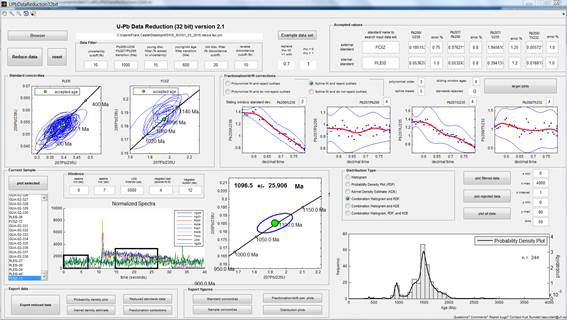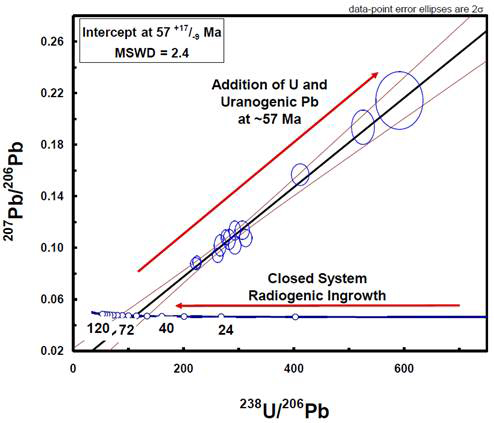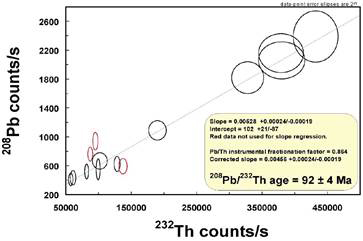Reports: ND255770-ND2: Uranium-Thorium-Lead Chronology of Source Rock Deposition and Diagenesis, an in Situ and Whole Rock Study TOC-Rich Shales
Thomas J. Lapen, University of Houston
Year 2
Major Scientific findings:
1) Redox-sensitive U can be significantly redistributed and preferentially incorporated into detrital phosphate grains (fish bone) during diagenesis of organic-rich shales. By tracing the isotopic compositions of uranogenic Pb, the timing of the U redistribution can be determined (Figure 1).
2) Thorium is not redistributed during diagenesis of organic-rich shale. Therefore, the Th-Pb isotope systematics of the fish bone clasts indicate the system is closed to Th redistributions. The Th-Pb isotopes of fish bone record the time of deposition or very early diagenesis. This represents a new method of dating organic-rich shale (Figure 2).
3) The timing of U redistribution pre-dates a period of igneous activity in west Texas, but overlaps in time of the Chixulub impact event 65 million years ago. Could the seismic energy from the impact, estimated to have been magnitude ~8 near the Eagle Ford rocks, have overpressured pore fluids and caused localized element redistributions in the Eagle Ford strata? We are currently testing this hypothesis.
4) The measured Pb isotopic compositions of fish bone phosphate indicate that the phosphate incorporated excess 231Pa and resultant U unsupported 207Pb during diagenesis. The hypothesized preferential 231Pa uptake in fish bone phosphate is being modeled.
Abstract from first manuscript (Slabic and Lapen, In Prep):
The U-Th-Pb isotope systematics of TOC (total organic carbon)-rich sedimentary rocks are investigated to test the potential for these isotope systems to record the timing of deposition and periods of diagenesis. The samples investigated were derived from the well-dated Upper Eagle Ford Formation (UEFF), within the Eagle Ford Group (EFG), located in south-central Texas. The sample material analyzed in this study is dated at 90.6 Ma based on the astro- and geochronologic age model of Eldrett et al. (2015). In situ analyses of U, Th, and Pb isotope ratios and rare earth element (REE) abundances of fish bone phosphate and carbonate calcispheres were conducted by laser ablation inductively-coupled plasma mass spectrometry (LA-ICP-MS) on materials collected from research core Iona-1. The core, located in Southwest Texas, was drilled by Shell International Exploration and Production Inc. in January 2012. Qualitative major element abundances and sample mapping were conducted by scanning electron microscopy (SEM) and energy dispersive spectroscopy (EDS). The REE data in fish bone indicates significant local REE uptake. Thorium-lead isotope data yield an age of 92±4 Ma and indicates that the fish bones have retained their original, or very early, diagenetic Th-Pb isotope systematics, making them promising candidates for dating shale deposition. The U-Pb isotope systematics indicate that U was mobilized and greatly enriched in the fish bone after deposition. Modeling of the U and Pb isotope data points to a short period of U and unsupported 207Pb re-distribution at 57 +17/-9 million years ago. This late U mobility may complicate interpretations of U isotope compositions as a proxy of paleoredox conditions.
Major Professional Accomplishments:
1) The grant supported the research of an undergraduate student, Ms. Ane Slabic, who is the first in her family to receive a bachelor’s degree and who drove most of the research. Her work resulted in an award-winning Senior Honors Thesis in the University of Houston Honors College. Her honors include:
a. 1st Place Undergraduate Poster Presentation at 31st Annual Student Research/Alumni & Industry Open House, University of Houston, 2016.
b. Awarded Best Poster at the Houston Geological Society Mudrocks and Applied Geoscience Conference, 2017.
c. 1st Place Undergraduate Poster Presentation at 32nd Annual Student Research/Alumni & Industry Open House, University of Houston, 2017.
d. Outstanding Senior Honors Thesis Award, the Honors College at the University of Houston, 2017.
e. Received a competitive NAGT/USGS internship in Menlo Park, CA, current.
2) The grant supported Mr. Kurt Sundell, who developed a graphical user interface (GUI) program (Figure 3) for real-time reduction of U-Th-Pb data during analysis. This program is being used extensively in our lab and is available to other labs.
3) The grant supported Dr. Xinyang Chen as a post-doctoral researcher and he investigated low-T stable isotopic fractions. His work on modern spring water systems is being written up.
4) This basic research has initiated application discussions with major oil companies in the Houston area.
Figure 1. Tera–Wasserburg plot of 207Pb/206Pb versus 238U/206Pb as measured for two fish bones tested in this study. Bottom blue line represents model ages for concordia for a closed system of radiogenic ingrowth (i.e., concordia models the concurrent and undisturbed operation of 238U-206Pb and 238U-207Pb isotope systems in a closed system). Point at which mixing array intersects concordia (57 +17-9 Ma) represents the age of re-distribution (i.e., age of disturbance) of 238U and Pb with an anomalous 207Pb/206Pb ratio. The anomalous ratio is likely due to preferential 231Pa uptake by the fish bone phosphate. Note that data plot back to concordia along a nearly linear path and tight array.
Figure 2: Plot of 208Pb counts/s (CPS) versus 232Th CPS as measured for the two representative fish bones. Black data are used in the slope and intercept regression; red data are excluded from the regression due to the presence of cracks and altered material. The age is determined from the slope of the data following the simple radioisotope decay equation: (D*/N) = (eλt-1) where D* = atoms of radiogenic daughter (208Pb); N = atoms of the parent nuclide (232Th); λ = decay constant for 232Th; t = time. The slope of the data array is proportional to age. The instrumental fractionation-corrected age is 92±4 Ma (2σ).
 Figure 3. MATLAB-based graphical user interface (GUI) designed for reducing integrated U-Pb data.
Figure 3. MATLAB-based graphical user interface (GUI) designed for reducing integrated U-Pb data.













